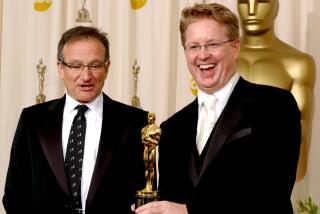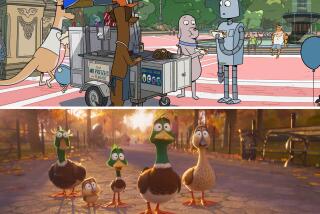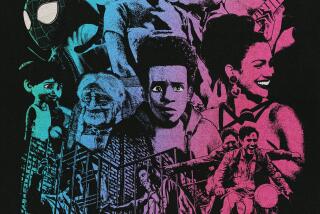‘Finding Nemo’: The ultimate summer movie or just the ultimate parenting movie?
The #UltimateSummerMovie Showdown is underway, and voters have chosen “Finding Nemo” (2003) as their winner for Week 5, dedicated to movies first released in theaters from May 29-June 4 (between 1975 and 2019). Times film critic Justin Chang sat down with entertainment columnists Mary McNamara and Glenn Whipp to discuss the movie, the chords it strikes with parents and children, and why so many of the best Pixar movies speak to both.
JUSTIN CHANG: After our recent run of Ultimate Summer Movie Showdown winners — the R-rated comedy of “Bridesmaids,” the visceral thrills of “Mad Max: Fury Road” and the nerve-shredding horror of “Alien” — I have to say I was pleasantly surprised to see this week’s crown go to a movie I could watch with my 3-year-old. Then I actually sat down and watched “Finding Nemo” with my 3-year-old and found myself covering her eyes in the first five minutes, so as to spare her the sight of a hungry barracuda wiping out a defenseless family of clownfish, save the dad, Marlin, and one poor unhatched larva named Nemo.
Disney has long been in the parent-killing business, as any traumatized “Lion King” fan will tell you. But I’m hard-pressed to think of another scene in the Disney/Pixar canon quite as emotionally unsparing as that “Finding Nemo” massacre, which has to set some sort of record for body count alone. The rest of the movie is nearly as traumatic: Not having seen it in a few years, I was startled anew by just how nonstop its perils are, how relentlessly it ushers poor Marlin and Dory (voiced by the splendidly matched Albert Brooks and Ellen DeGeneres) from one near-death experience to the next. One of Pixar’s great strengths as a brand has always been its refusal to spare your emotions — that’s true if you’re a kid, and maybe doubly true if you’re an adult.
Mary and Glenn, I’m eager to dive into this one with you, not just because “Finding Nemo” is a great family movie, but it’s also a pretty great movie about family. I haven’t been a parent as long as you both have, but this was my first time rewatching the film through a dad’s eyes, and it’d be silly of me to pretend it didn’t play differently this time — more harrowing, and more humbling too. Marlin may fail in the dad-joke department, but he is nevertheless the ultimate helicopter parent. As such, he’s pretty obnoxious a lot of the time — but also more relatable than I care to admit.
MARY McNAMARA: Good Lord, Justin. Pull yourself together, man. Disney movies have never been for the faint of heart, their number one rule being: First, we kill the mom. And not to get into a political debate I am sure we would all rather avoid, but the only actual clownfish death is mom’s; the rest were still eggs. (Think about that the next time you have caviar). But parenthood does make cowards of us all; I still have a very hard time accepting a child’s death as a plot point in film or television while my children sail right on past.
One thing that makes “Finding Nemo” so exceptional is that while it follows the absent-parent requirement of most children’s stories (because we all know kids can’t have any real adventures if the parents are around), it also calls the trope out. When Marlin says, “I promised I’d never let anything happen to him,” Dory answers, “That’s a funny thing to promise … then nothing would ever happen to him.”
Usually the story of a missing child is told from either the vantage of the searching parent (think Liam Neeson and his set of “particular skills”) or the child trying to get home (everything from “Kidnapped” to “Wizard of Oz”). “Finding Nemo” does both. Nemo learns to respect limits and Marlin learns not to be controlled by them.
I can’t think of another movie that allows parent and child their own exciting journeys, complete with separate sets of wonderful supporting characters. That construct was simply brilliant because that’s what family is like — separate journeys together, with everyone relying on people (or marine creatures) outside the family as well.
Oh, and Dory is one of the greatest characters in literary history, period. Like “David Copperfield’s” Aunt Betsy and Mr. Dick rolled into one, she is unfettered by neuroses or ego (because she can’t remember enough to have them) and understands that the simplest solution is usually the best. Also, she speaks whale.
GLENN WHIPP: I also watched this with my daughter when she was 3, first at the El Capitan Theatre with all the bells and whistles and the Wurlitzer pipe organ that sinks into the stage floor, and then countless times at home. We had Nemo bath toys, Nemo beach toys, Nemo pajamas that she wore that entire summer. And I loved every moment of this year-long obsession, right down to leaving the TV on just to see the DVD’s home screen, displaying that gorgeous, undersea ocean imagery that was so vivid that it felt like it cooled our home’s temperature by a good 10 degrees.
I appreciate the universe’s cosmic (comic?) timing in dropping this particular movie in my lap for our summer movie series, arriving as it did just a couple of days after my 17-year-old son was involved in a serious car crash. The idea of revisiting a film about a father’s aching worry and concern over the fate of his beloved child wasn’t exactly inviting, particularly given my track record of openly sobbing while watching Pixar movies in theaters with my kids. (My daughter couldn’t understand my tears during “Bao,” the studio’s Oscar-winning empty-nest dumpling short … but she will someday!)
But when I sat down to watch “Finding Nemo” again, alone, bereft, I was struck anew at how the filmmakers didn’t shy away from the treacherous perils of its brightly colored undersea world, from that harrowing opening scene through a rescue and escape that can only be described as miraculous. I appreciated that candor. It felt real. And, as you mentioned, Mary, Dory questioning Marlin about his silly promise to Nemo is just brilliant, though, as an often emotionally inarticulate dad, I found Crush’s parenting wisdom about letting go perhaps a bit more relatable: “You never really know, but when they know you’ll know, you know.” Trust me, I know.
CHANG: Glenn, I’m glad your son is OK and on the mend. I’m also glad you love “Bao,” another high point in Pixar’s ongoing commitment to parent-child reconciliation. The one that reduced me to a sobbing wreck right there in the theater? The flawed but curiously underappreciated “Brave,” whose finale struck the rawest of chords with me — and made me wish Pixar and other animation studios told mother-daughter stories more often.
Father-son dramas are generally more common, though “common” is not a word you would apply in any sense to “Finding Nemo.” It’s maybe a little ironic that Crush and Dory advance a go-with-the-flow philosophy in a movie that was clearly assembled by an army of control freaks. I don’t know if this is director Andrew Stanton’s best work — for sheer visual and emotional grandeur, his “WALL-E” is hard to beat — but even after 17 years, it’s hard to study a single frame of “Nemo” and not be thoroughly, optically bedazzled by it. You could spend an hour replaying those early shots of the coral reef that Marlin and Nemo call home — or that lyrical, terrifying scene in which Marlin and Dory get swarmed by jellyfish — and still not catch every eye-tickling detail.
You could also miss some of the movie’s grace notes, among them its sly, empathetic portrait of disability. Marlin worries excessively about Nemo because of his undersize “lucky fin,” a remnant of that scary prenatal attack. But then Nemo goes to school and almost immediately befriends a squid with an undersized tentacle and a seahorse with an “H2O intolerance”; you know (even if Marlin doesn’t) that he’s going to be fine. And then, of course, there’s Dory, indeed the movie’s heart and sole — ahem, soul — whose short-term memory loss is both a gentle source of comedy and a poignant reminder that life is all about embracing imperfection, in ourselves and each other. Stanton and DeGeneres would go on to explore Dory’s psyche with “Memento” levels of intricacy in the delightful “Finding Dory,” one of the better Pixar sequels by far, in no small part due to the brilliance of the original foundation.
McNAMARA: And the sharks in their carnivores anonymous meeting! Everyone’s struggling with something. And the image of the tiny clownfish in the giant ocean perfectly captures what we all feel at some point or another — that we are alone in a strange and hostile place.
It really is the perfect road movie — not only is the “scenery” gorgeous, but all the characters Marlin and Dory meet along the way are hilarious and amazing. Crush and Squirt for sure, but also the mimicking school of fish, and Nigel the pelican, the crazy seagulls and even the fighting crabs. Same for all the fish in the tank where Nemo winds up. They are all weird and imperfect and amazing in their weird imperfectness. (It also doesn’t hurt that the cast is killer from start to finish.) So many great lines, so many great memes — the humor is almost always enough to appeal to small children and clever enough to stick with the adult audience. The seagull squawk of “Mine, mine, mine” is truly a universal language.
But I do want to say one more thing about Dory. I first saw “Finding Nemo” with my husband, our two young children and my mom. We all loved it (and thank you, Pixar, for all the subsequently complaint-free visits to the aquarium), but my mom, who was moving past the early stages of dementia, really loved Dory. Every time Dory lost track of the plot, Mom would squeeze my arm, and when Dory’s moment of fear occurred, Mom and I were both stifling sobs. But even though she can’t remember Nemo’s name, or that she does indeed speak whale, Dory pretty much saves the day every time. That meant a lot to my mother, and to all of us as we faced those particular challenges as a family. After that, whenever she would forget something or lose track of what was happening, one of the kids would say, “just like Dory,” and that would make her laugh, and everyone relax. So whether intentionally or not, “Finding Nemo” really hit the anxieties and resilience of parents and children at every age.
And now, if you’ll excuse me, I am going to round up my family and demand we all watch “Finding Nemo” for the 150th time. Sniff.
WHIPP: Good God. Just talking about Pixar movies makes us cry! That’s a result of the emotionally astute storytelling, to be sure, as well as the almost cruel way they have of piercing parents’ hearts with all these films about how we have to let our kids go off and do their own thing. They literally made Sadness a character in one of their movies. And don’t even get me started on Bing Bong or I will absolutely lose it. (When does “Inside Out” come up for this Summer Movie Showdown? Asking so I can go into protective hiding that week.)
But Mary, your beautiful story illustrates another aspect of why these films get to us — we watch them together as families, even if, sometimes, those families aren’t blood relations, but more like the the plucky group in the dentist’s office aquarium. My kids, now 19 and 17, still want to watch Pixar movies with me, both when they arrive in theaters (we still get giddy when we see that Luxo Jr. desk lamp bounce onscreen) and, later, at home. Hopping between hubs on the Disney+ streaming site, Pixar will always be the consensus choice over a “Star Wars” or Marvel movie for any one of a hundred reasons. But ultimately, it comes down to their indelible characters that remind us of our humanity — even when they take the form of a forgetful blue tang fish.
The L. A. Times Ultimate Summer Movie Showdown
Who: “Finding Nemo” director Andrew Stanton in conversation with Times film critic Justin Chang
When: 6 p.m. June 18
Where: Free virtual event will be livestreamed on the L.A. Times Classic Hollywood Facebook Page and YouTube, as well as Twitter
More to Read
Only good movies
Get the Indie Focus newsletter, Mark Olsen's weekly guide to the world of cinema.
You may occasionally receive promotional content from the Los Angeles Times.













